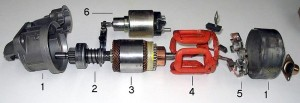What is a starter Motor?
A starter motor is a device that is capable of turning over an internal combustion engine until the process of combustion takes over. This is typically accomplished by providing the necessary mechanical energy to rotate the crankshaft for a given number of cycles. While the starter motor is rotating the crankshaft, the engine begins the process of combustion. The starter is then able to disengage once the engine is running under its own power. Most automotive starter motors are electric, but some applications use pneumatic or hydraulic power.
A starter motor is a device that is capable of turning over an internal combustion engine until the process of combustion takes over. This is typically accomplished by providing the necessary mechanical energy to rotate the crankshaft for a given number of cycles. While the starter motor is rotating the crankshaft, the engine begins the process of combustion. The starter is then able to disengage once the engine is running under its own power. Most automotive starter motors are electric, but some applications use pneumatic or hydraulic power.
How do Electric Starter Motors Work?
Internal combustion engines are typically incapable of “self starting,” which means they require some external force to start running. This is typically accomplished by using some method to turn the crankshaft until the process of combustion can take over. The single most common example is an electric starter motor that engages with a toothed flywheel.
The electric starter motor or cranking motor is the most common type used on gasoline engines and small diesel engines. The modern starter motor is either a permanent-magnet or a series-parallel wound direct current electric motor with a starter solenoid (similar to a relay) mounted on it. When DC power from the starting battery is applied to the solenoid, usually through a key-operated switch (the "ignition switch"), the solenoid engages a lever that pushes out the drive pinion on the starter drive shaft and meshes the pinion with the starter ring gear on the flywheel of the engine.
The solenoid also closes high-current contacts for the starter motor, which begins to turn. Once the engine starts, the key-operated switch is opened, a spring in the solenoid assembly pulls the pinion gear away from the ring gear, and the starter motor stops. The starter's pinion is clutched to its drive shaft through an overrunning-clutch which permits the pinion to transmit drive in only one direction. In this manner, drive is transmitted through the pinion to the flywheel ring gear, but if the pinion remains engaged (as for example because the operator fails to release the key as soon as the engine starts, or if there is a short and the solenoid remains engaged), the pinion will spin independently of its drive shaft. This prevents the engine driving the starter, for such backdrive would cause the starter to spin so fast as to fly apart.
The standard starter motor is typically designed for intermittent use, which are designed only to operate for typically under 30 seconds before overheating. It is recommended to pause for at least ten seconds after each ten or fifteen seconds of cranking the engine, when trying to start an engine that does not start immediately.
Internal combustion engines are typically incapable of “self starting,” which means they require some external force to start running. This is typically accomplished by using some method to turn the crankshaft until the process of combustion can take over. The single most common example is an electric starter motor that engages with a toothed flywheel.
The electric starter motor or cranking motor is the most common type used on gasoline engines and small diesel engines. The modern starter motor is either a permanent-magnet or a series-parallel wound direct current electric motor with a starter solenoid (similar to a relay) mounted on it. When DC power from the starting battery is applied to the solenoid, usually through a key-operated switch (the "ignition switch"), the solenoid engages a lever that pushes out the drive pinion on the starter drive shaft and meshes the pinion with the starter ring gear on the flywheel of the engine.
The solenoid also closes high-current contacts for the starter motor, which begins to turn. Once the engine starts, the key-operated switch is opened, a spring in the solenoid assembly pulls the pinion gear away from the ring gear, and the starter motor stops. The starter's pinion is clutched to its drive shaft through an overrunning-clutch which permits the pinion to transmit drive in only one direction. In this manner, drive is transmitted through the pinion to the flywheel ring gear, but if the pinion remains engaged (as for example because the operator fails to release the key as soon as the engine starts, or if there is a short and the solenoid remains engaged), the pinion will spin independently of its drive shaft. This prevents the engine driving the starter, for such backdrive would cause the starter to spin so fast as to fly apart.
The standard starter motor is typically designed for intermittent use, which are designed only to operate for typically under 30 seconds before overheating. It is recommended to pause for at least ten seconds after each ten or fifteen seconds of cranking the engine, when trying to start an engine that does not start immediately.
Electric Starter Motor Components
There are a few different kinds of electric starter motors, but they typically include these basic components:

-
Housing
-
Overrunning clutch (Bendix drive)
-
Armature
-
Field Coils
-
Brushes
-
Solenoid
-
Engage Lever
There are a few different kinds of electric starter motors, but they typically include these basic components:
- Housing
- Overrunning clutch (Bendix drive)
- Armature
- Field Coils
- Brushes
- Solenoid
- Engage Lever



No comments:
Post a Comment